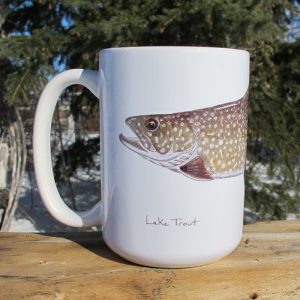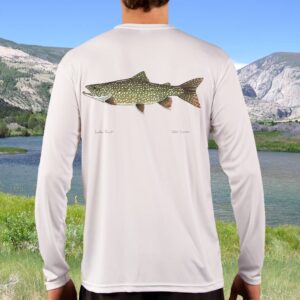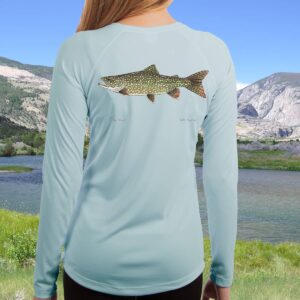(Salvelinus namaycush)
Description
Lake trout are char found mainly in lakes of North America. They are beautiful fish, usually olive gray in color and covered in white spots. Unlike other char they have a distinctly forked tail.
Size
 Lake trout can obtain huge sizes of more than 45 inches and more than 50 pounds. While monster lakers of this size are rare these days, 3 to 5 pound lakers are common in most lakes where they are found. Although I’ve yet to take a big lake trout on the fly, I spent year’s ice fishing for them on Lake Superior and on the lakes of Wyoming. I hoisted my share of 20 pound lakers from depths as much as 200 feet. My largest was this 26 pound monster from Fremont Lake near Pinedale, Wyoming.
Lake trout can obtain huge sizes of more than 45 inches and more than 50 pounds. While monster lakers of this size are rare these days, 3 to 5 pound lakers are common in most lakes where they are found. Although I’ve yet to take a big lake trout on the fly, I spent year’s ice fishing for them on Lake Superior and on the lakes of Wyoming. I hoisted my share of 20 pound lakers from depths as much as 200 feet. My largest was this 26 pound monster from Fremont Lake near Pinedale, Wyoming.
Distribution
 Lake trout are native only to northern North America. They have been introduced to many other cold deep lakes including many lakes in the Rocky Mountains. Today some of the best lake trout fisheries exist where they are nonnative such as Idaho, Montana and Wyoming and including Yellowstone National Park.
Lake trout are native only to northern North America. They have been introduced to many other cold deep lakes including many lakes in the Rocky Mountains. Today some of the best lake trout fisheries exist where they are nonnative such as Idaho, Montana and Wyoming and including Yellowstone National Park.
Habits
Lake trout are known as fish that live in deep water however there are exceptions. Right after ice out lakers can be found in shallow water feeding on baitfish. They forage here until water temperatures get above 50 degrees before returning to the deep. Then again in fall, when water temperatures cool back down, they return to the shallows to spawn.
 Like any other creature, lakers need a nearby food source. Though their favorite foods are smaller fish, lakers can adapt. In the Rocky Mountain lakes, few baitfish exist down deep. Lucky for the lakers, high elevation Rocky Mountain lakes experience cold nights even during summer and they can prowl the shallows for baitfish before sunrise. During the rest of the day they feed on plankton and aquatic insects. I recently caught a 7 pound laker with a stomach packed full of lime green cased caddis!
Like any other creature, lakers need a nearby food source. Though their favorite foods are smaller fish, lakers can adapt. In the Rocky Mountain lakes, few baitfish exist down deep. Lucky for the lakers, high elevation Rocky Mountain lakes experience cold nights even during summer and they can prowl the shallows for baitfish before sunrise. During the rest of the day they feed on plankton and aquatic insects. I recently caught a 7 pound laker with a stomach packed full of lime green cased caddis!
Personal Experience
 For me, there’s always been a mystery with lake trout. I think it’s because of growing up summers fishing on Lake Winnipesaukee in New Hampshire. Lake Winnipesaukee has lake trout yet in all my summers I never caught a single one. Its simple, the summers were hot, the lakers were deep and I wasn’t fishing for them. But I knew they were there, right at my finger tips. That became more apparent when I was a teenager working at the Libby Museum and someone brought in a 16 pound laker to show us. From that day on I was consumed on learning how to catch them.
For me, there’s always been a mystery with lake trout. I think it’s because of growing up summers fishing on Lake Winnipesaukee in New Hampshire. Lake Winnipesaukee has lake trout yet in all my summers I never caught a single one. Its simple, the summers were hot, the lakers were deep and I wasn’t fishing for them. But I knew they were there, right at my finger tips. That became more apparent when I was a teenager working at the Libby Museum and someone brought in a 16 pound laker to show us. From that day on I was consumed on learning how to catch them.
After seeing that 16 pound laker I was quickly off to Northland College in the Northwoods of Wisconsin. While normal college students studied for classes I schooled myself on Chequamegon Bay. But in four years I caught everything but lake trout.
When I moved to Wyoming after college is when my lake trout fishing came together. Rocky Mountain lakes offered opportunities to catch lakers in shallow water. The lakers were abundant and to my delight, easy to catch. Although I conquered them on the fly rod my passion became jigging for them through the ice. This proved to be the best chance to catch big ones. In 1989 I iced my first beast, a 24 pounder on Jenny Lake in Grand Teton National Park during a blizzard. The day was one of the top fishing days in my life. Since then I’ve caught more than fifty large “Mackinaw”.
Fly Fishing Tactics for Lake Trout
 Fly fishing for lake trout starts with getting the fly to the fish. Lake trout in their native waters live deep most of the year and therefore getting the fly to them can be difficult. There are fast sinking fly lines that get you down but it still requires patience and skill. The challenge can be great fun and even if you’re not deep to their level you can still catch them. Lakers often ambush suspended fish well above them. Therefore if a hungry laker sees your fly 30 feet above he may charge up and get it.
Fly fishing for lake trout starts with getting the fly to the fish. Lake trout in their native waters live deep most of the year and therefore getting the fly to them can be difficult. There are fast sinking fly lines that get you down but it still requires patience and skill. The challenge can be great fun and even if you’re not deep to their level you can still catch them. Lakers often ambush suspended fish well above them. Therefore if a hungry laker sees your fly 30 feet above he may charge up and get it.
I prefer to target lakers when they’re in shallow water. This means I fly fish for them right after ice out and before ice up. I still use sinking lines because in shallow water my fly must be near bottom. Brightly colored chartreuse, white and yellow flies work excellent. Don’t strip too fast as lakers have a more lazy approach than say a speedy brook trout.
 If your one of those who think lake trout don’t fight, than you haven’t caught enough of them. Lakers do fight. Sure they don’t jump and many times they just twist their way all the way in. But when you hook one two weeks after ice out in shallow water, buckle up! Lakers are at their strongest at this time of year and when hooked in the shallows it causes them shear terror. Make sure you have some heavy tippet and a beefy 8-weight!
If your one of those who think lake trout don’t fight, than you haven’t caught enough of them. Lakers do fight. Sure they don’t jump and many times they just twist their way all the way in. But when you hook one two weeks after ice out in shallow water, buckle up! Lakers are at their strongest at this time of year and when hooked in the shallows it causes them shear terror. Make sure you have some heavy tippet and a beefy 8-weight!
Equipment
Rod: 9-foot for an 8-weight line.
Reel: A reel with a strong smooth drag will help against a long deep run.
Line: 8-weight, weight forward sinking, WF8S.
Leader: 6 to 71/2-foot for 10 to 16-pound tippet.
Flies: The best hook sizes are from 2/0 to 6. I’ve had my best luck with bright colors such as chartreuse, yellow and white. Excellent patterns include the Clouser Minnow, conehead wooly bugger and Lefty’s Deceiver.
Jeff’s Lake Trout Art
Get Jeff’s lake trout artwork on a variety of products by visiting his new and growing online store. Order one of his famous 15 oz coffee mugs a frosted beer mug a solar shirt or hoodie. You can even commission Jeff to paint the one you caught!






